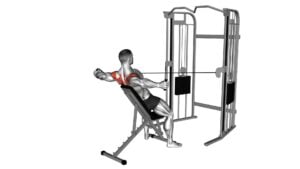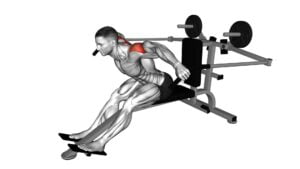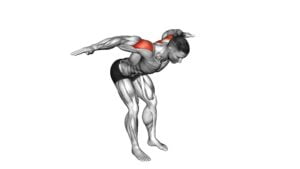Kettlebell Rear Fly – Video Exercise Guide & Tips

Are you looking for a quick and effective way to strengthen your upper back and shoulders? Look no further than the kettlebell rear fly!
Watch This Exercise Video
This exercise targets those hard-to-reach muscles and improves your posture.
In this video exercise guide, we'll show you the proper form and technique, as well as variations and progressions to keep challenging yourself.
Avoid common mistakes and maximize your results with our helpful tips.
Get ready to feel the burn and see results with the kettlebell rear fly!
Key Takeaways
- Targets hard-to-reach muscles in the upper back and shoulders
- Improves posture
- Strengthens the rhomboids, traps, and rear deltoids
- Enhances shoulder stability and overall upper back strength
Benefits of the Kettlebell Rear Fly
You will experience significant upper back and shoulder strength gains when performing the Kettlebell Rear Fly exercise. This exercise targets multiple muscles in your upper body, including the rhomboids, traps, and rear deltoids. By strengthening these muscles, you can improve your posture and reduce the risk of developing upper back and shoulder pain.
The Kettlebell Rear Fly primarily focuses on the rhomboids, which are located between your shoulder blades. These muscles play a crucial role in retracting and stabilizing your shoulder blades, helping to maintain proper posture. By strengthening the rhomboids, you can improve your posture and prevent slouching, which can lead to neck and shoulder strain.
In addition to the rhomboids, the Kettlebell Rear Fly also targets the traps and rear deltoids. The traps, or trapezius muscles, are responsible for shrugging your shoulders and rotating your shoulder blades. Strengthening these muscles can enhance your shoulder stability and improve your overall upper back strength.
Proper Form and Technique
To perform the Kettlebell Rear Fly with proper form and technique, focus on maintaining a strong and stable core throughout the exercise. This will help you maximize results and prevent any potential injury.
Start by standing with your feet hip-width apart and holding the kettlebell with both hands in front of your thighs. Hinge at the hips and slightly bend your knees as you bring your torso forward. Keep your back straight and engage your core as you lift the kettlebell straight out to the sides, squeezing your shoulder blades together.
Make sure to keep your arms slightly bent and your wrists straight throughout the movement. Avoid any swinging or jerking motions and maintain control over the kettlebell at all times.
For training frequency recommendations, it's generally recommended to perform this exercise 2-3 times a week, allowing for adequate rest and recovery between sessions.
Remember to start with a weight that challenges you but still allows you to maintain proper form. As you progress, you can gradually increase the weight to continue challenging your muscles and promoting growth.
Equipment and Weight Selection
To select the appropriate equipment and weight for the Kettlebell Rear Fly exercise, consider your current fitness level and choose a kettlebell that challenges your muscles without compromising your form. Here are some factors to keep in mind when making your equipment selection and weight recommendations:
- Fitness Level:
- Beginners: If you're new to kettlebell exercises or have limited strength, start with a lighter kettlebell to focus on proper form and technique.
- Intermediate: As you progress and become more comfortable with the exercise, you can gradually increase the weight of the kettlebell to continue challenging your muscles.
- Advanced: If you have been regularly practicing kettlebell exercises and have developed good strength and form, you can opt for a heavier kettlebell to further intensify the workout.
- Muscle Strength:
- Upper Body: Consider the strength of your upper body muscles, especially the shoulders and back, as these are the primary muscles targeted in the Kettlebell Rear Fly exercise.
- Grip Strength: Pay attention to your grip strength, as a heavier kettlebell may require a stronger grip to maintain control throughout the exercise.
- Personal Preference and Comfort:
- Experiment with different kettlebell sizes and handle types to find the one that feels most comfortable and allows you to maintain proper form throughout the exercise.
Variations and Progressions
When progressing the Kettlebell Rear Fly exercise, incorporate variations to challenge your muscles in different ways. By changing the angle of your body or the position of your arms, you can target different muscle groups and increase the training intensity.
One variation you can try is the Bent Over Rear Fly, where you bend at the hips and keep your back flat while performing the exercise. This variation puts more emphasis on your lower back and hamstrings.
Another variation is the Single Arm Rear Fly, where you perform the exercise with one arm at a time. This variation helps to improve balance and stability while also increasing the workload on the targeted muscles.
To further increase the training intensity, you can use a heavier kettlebell or increase the number of repetitions. Remember to always maintain proper form and technique to prevent any injuries.
Common Mistakes to Avoid
When performing the kettlebell rear fly, it's important to avoid common mistakes that can lead to incorrect form and potential dangers.
One common mistake is overextending the arms, which can put unnecessary strain on the shoulders and increase the risk of injury.
Additionally, neglecting proper breathing technique can limit the effectiveness of the exercise and compromise your stability.
Incorrect Form Dangers
Avoid using too heavy of a kettlebell when performing the kettlebell rear fly exercise, as this can lead to incorrect form and potential injury. It's important to maintain proper body alignment throughout the exercise to minimize the risks of incorrect form.
Here are some common mistakes to avoid:
- Arching your back: Keep your spine straight and engage your core to prevent excessive strain on your lower back.
- Shrugging your shoulders: Relax your shoulders and keep them down throughout the movement to avoid tension in the neck and upper traps.
- Swinging the kettlebell: Maintain control and perform the exercise in a slow and controlled manner to target the intended muscles effectively.
By being mindful of these form errors, you can reduce the risk of injury and maximize the benefits of the kettlebell rear fly exercise.
Now, let's explore the risks associated with overextending your arms.
Overextending Arms Risks
To minimize the risks of overextending your arms during the kettlebell rear fly exercise, make sure to maintain proper alignment and avoid excessive strain on your joints. Overextending your arms can lead to injury risks, such as muscle strains, ligament sprains, and even joint damage. When performing the kettlebell rear fly, keep your elbows slightly bent and avoid locking them out at the end of the movement. This will help prevent overextension and reduce the stress on your arms and shoulders.
Additionally, focus on engaging your back muscles and using them to lift the kettlebell, rather than relying solely on your arms. By maintaining proper form and alignment, you can minimize the risk of overextending your arms and maximize the effectiveness of the exercise.
Now let's move on to the next important aspect of the kettlebell rear fly: neglecting proper breathing.
Neglecting Proper Breathing
Don't overlook the importance of proper breathing while performing the kettlebell rear fly exercise. Breathing exercises play a crucial role in maximizing the effectiveness of this exercise and preventing injury.
Here are some common mistakes to avoid when it comes to breathing:
- Holding your breath: Many people tend to hold their breath while performing strenuous exercises. This can lead to increased strain on your muscles and may cause dizziness or lightheadedness. Remember to inhale and exhale throughout the movement.
- Shallow breathing: It's important to take deep breaths during the kettlebell rear fly exercise. Shallow breathing restricts oxygen flow to your muscles, reducing their ability to perform optimally.
- Inconsistent breathing: Maintain a steady rhythm of breathing during the exercise. This will help you stay focused and maintain control of the movement.
Tips for Maximizing Results
To maximize your results with the kettlebell rear fly exercise, it's important to focus on proper form techniques. This includes maintaining a straight back, engaging your core muscles, and keeping your shoulders relaxed.
Additionally, training frequency is key. Aim to incorporate the kettlebell rear fly into your workout routine at least 2-3 times per week for optimal results.
Proper Form Techniques
You can maximize your results by ensuring proper form techniques during the kettlebell rear fly exercise. To achieve this, it's important to avoid common mistakes that can compromise your form and hinder your progress. Here are some tips to help you maintain proper form:
- Keep your back straight and engage your core throughout the exercise.
- Maintain a slight bend in your knees and hinge forward at the hips.
- Keep your shoulder blades retracted and your chest open.
- Focus on your breathing technique, inhaling as you lower the kettlebell and exhaling as you raise it.
- Avoid using excessive momentum by controlling the movement and using a weight that challenges you without sacrificing form.
Training Frequency Recommendations
For optimal results, aim to incorporate the kettlebell rear fly exercise into your routine at least three times a week. This frequency allows you to train with enough intensity to challenge your muscles and stimulate growth, while also providing adequate rest and recovery time.
Training intensity is crucial for achieving maximum results as it ensures that your muscles are being pushed to their limits, promoting strength and muscle development. However, it's equally important to prioritize rest and recovery to prevent overtraining and minimize the risk of injury.
Frequently Asked Questions
How Many Sets and Repetitions Should I Do for the Kettlebell Rear Fly Exercise?
For optimal results with the kettlebell rear fly exercise, it's important to focus on both the weight and form. Start with a weight that challenges you, but allows you to maintain proper technique.
Aim for 3-4 sets of 8-12 repetitions, ensuring that you feel the muscles working without sacrificing form.
As you progress, you can increase the weight or repetitions to continue challenging your muscles.
There are also variations and progressions available to further intensify the workout.
Is the Kettlebell Rear Fly Suitable for Beginners or Should It Be Reserved for More Advanced Lifters?
The kettlebell rear fly can be suitable for beginners, but it's important to start with lighter weights and focus on proper form. To modify for beginners, you can use a resistance band instead of a kettlebell or reduce the range of motion.
Common mistakes to avoid include rounding your back, using too much weight, and swinging the kettlebell. Remember to engage your core and squeeze your shoulder blades together for maximum benefit.
Can the Kettlebell Rear Fly Help Improve Posture and Reduce Back Pain?
The kettlebell rear fly exercise can be beneficial for improving posture and providing back pain relief. By engaging the muscles in your upper back and shoulders, this exercise helps strengthen the muscles that support your spine. As a result, you may experience improved posture and reduced back pain.
However, it's important to start with lighter weights and focus on proper form, especially if you're a beginner. Consult with a fitness professional for guidance.
Are There Any Specific Muscle Groups Targeted by the Kettlebell Rear Fly Exercise?
The kettlebell rear fly exercise targets specific muscles in your upper back and shoulders. By performing this exercise, you can strengthen your posterior deltoids, rhomboids, and trapezius muscles. This not only helps improve your posture but also reduces back pain.
The kettlebell rear fly offers several benefits, including increased upper body strength and improved stability. Incorporating this exercise into your routine can help you achieve a stronger and healthier upper body.
Can I Substitute Kettlebells With Dumbbells for the Rear Fly Exercise?
Yes, you can substitute kettlebells with dumbbells for the rear fly exercise. Using dumbbells for this exercise offers similar benefits as kettlebells.
Dumbbells allow for a wider range of motion and give you more control over the weight. They also target the same muscle groups, such as the rear deltoids and upper back muscles.
Conclusion
In conclusion, the kettlebell rear fly is a highly effective exercise for targeting the muscles in your back and shoulders. By maintaining proper form and technique, selecting the appropriate weight, and incorporating variations and progressions, you can maximize the benefits of this exercise.
Avoiding common mistakes and following the provided tips will further enhance your results. Incorporate the kettlebell rear fly into your workout routine to strengthen and tone your upper body.

Author
Years ago, the spark of my life’s passion ignited in my mind the moment I stepped into the local gym for the first time. The inaugural bead of perspiration, the initial endeavor, the very first surge of endorphins, and a sense of pride that washed over me post-workout marked the beginning of my deep-seated interest in strength sports, fitness, and sports nutrition. This very curiosity blossomed rapidly into a profound fascination, propelling me to earn a Master’s degree in Physical Education from the Academy of Physical Education in Krakow, followed by a Sports Manager diploma from the Jagiellonian University. My journey of growth led me to gain more specialized qualifications, such as being a certified personal trainer with a focus on sports dietetics, a lifeguard, and an instructor for wellness and corrective gymnastics. Theoretical knowledge paired seamlessly with practical experience, reinforcing my belief that the transformation of individuals under my guidance was also a reflection of my personal growth. This belief holds true even today. Each day, I strive to push the boundaries and explore new realms. These realms gently elevate me to greater heights. The unique combination of passion for my field and the continuous quest for growth fuels my drive to break new ground.







